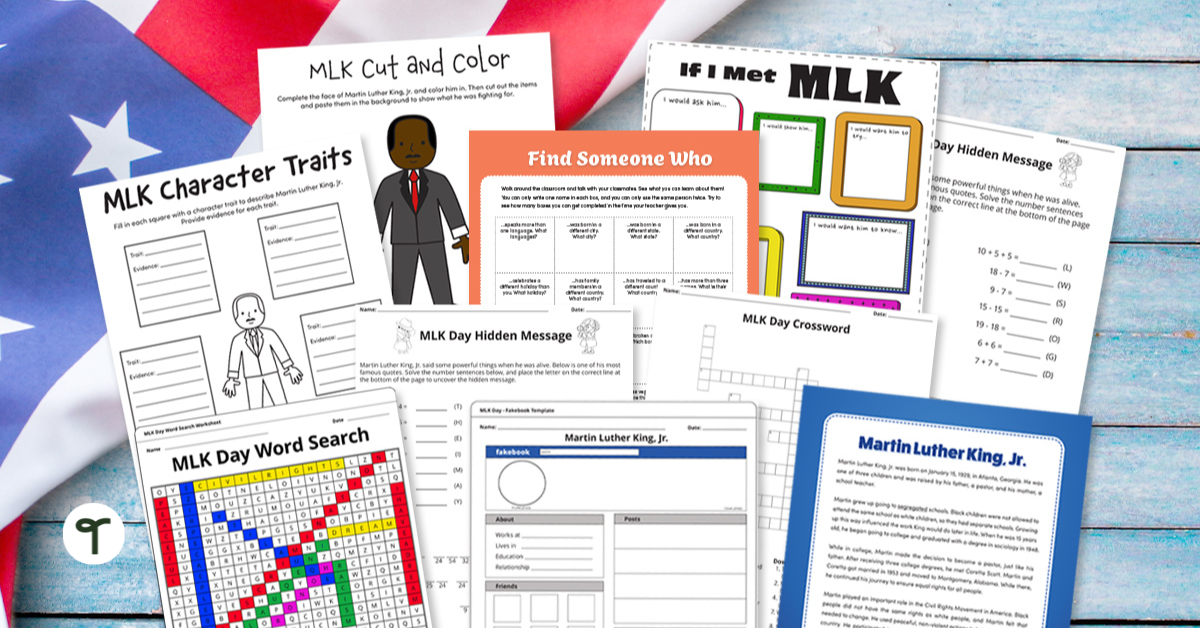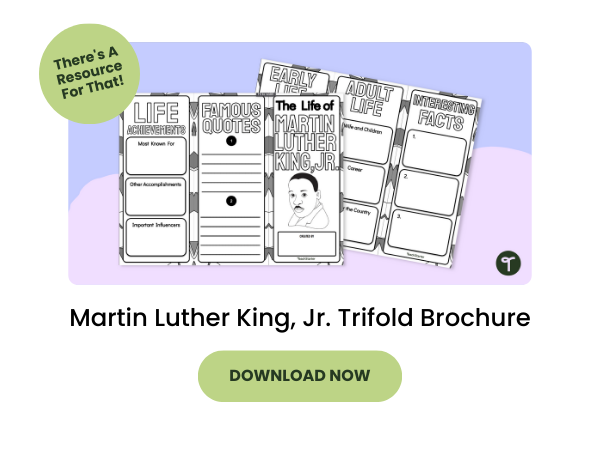Sometimes a few facts are all you need to spark inspiration in the classroom, which is why we’ve put together a comprehensive list of Martin Luther King Jr. facts to help you kick off the new year! With MLK Day right around the corner, these facts will help your students feel more connected to this American hero.
You can add them to your Morning Meetings, share on the whiteboard throughout the month, use them as writing prompts, or discuss each one with your students in greater detail. The sky is the limit!
These facts can help you outline a timeline of Dr. King’s life for your class and demonstrate that great leaders can come from the humblest of beginnings. Martin Luther King Jr. showed the world that injustice can be fought through peaceful means, which in many ways is more difficult than violence.
Dr. King also demonstrated to stand up for what is right, even if it takes a long time (or your whole life!) to see it through. Although MLK had a short life, his accomplishments exceeded that of millions of people who lived twice or three times as long.
The teacher team at Teach Starter has also included resources and discussion questions to make your lessons well-rounded and well-prepared.
Let’s start things off with the answers to some common kid questions about Martin Luther King, Jr.!
Is Martin Luther King Jr. Day a Federal Holiday?
Yes, Martin Luther King Jr. Day is a federal holiday. In fact, Dr. King was the first modern private citizen to be honored with an American federal holiday. Many students may see MLK Day as a free day off school, but as educators, we must emphasize why this civil rights leader deserves recognition and respect every year.
Is MLK Day the Same Every Year?
It’s a question that a lot of us have — not just children — so it’s worth revisiting. Martin Luther King Jr. Day is celebrated on the third Monday of January each year. MLK Day was officially established in 1986, long after attempts at honoring King started soon after his death in 1968. Many people, including the famous musician Stevie Wonder, helped make this happen.
Facts About Martin Luther King Jr.
Once you’ve announced when we celebrate MLK Day to your students, these facts about Martin Luther King Jr.’s life and work can help spark your students’ interest and shape your conversations.
The following items of biographical information may assist you in creating your Morning Meeting discussion topics and explaining MLK Day to your class. Depending on your students’ grade level, you can pick and choose which are most appropriate for your lessons.
- Martin Luther King Jr. was born on January 15, 1929 in Atlanta, Georgia.
- Martin Luther King Jr. wasn’t born with this famous name. He was named Michael King until his father changed his name in 1935. You may often see him referred to by his initials, MLK.
- One of the formative experiences with segregation that Dr. King experienced as a child involved a white friend’s father who wouldn’t allow him to play with his son anymore. This occurred when young Martin was just 6 years old.
- One of King’s first jobs at 13 was delivering papers. He became the youngest assistant manager for the Atlanta Journal delivery station.
- MLK attended segregated schools as a child. Raised in Georgia, King attended elementary and high school in a place where Black and white students were not allowed to attend the same schools.
- Dr. King skipped his last year of high school and started college at just 15 years old.
- MLK attended Morehouse College, Crozer Theological Seminary and Boston University, eventually earning a PhD in theology. It’s because of that doctorate that he is often called “Dr.” King. He believed that education and social justice were closely aligned.
- Throughout his life, Martin Luther King Jr. was honored with at least 20 honorary degrees from institutions such as Bard College, Yale and Howard University.
- MLK became a pastor of the Dexter Avenue Baptist Church in 1954. You may have heard him referred to by the title Reverend Martin Luther King.
- MLK met his wife, Coretta Scott, in the early 1950s, and they married in 1953. Coretta Scott was highly educated and accomplished compared to many women of her time. She attended the New England Conservatory of Music and Antioch College and earned two bachelor’s degrees.
- Martin Luther King Jr. and Coretta Scott King had four children who are mentioned in his famous “I Have a Dream” speech. In the speech, Dr. King says of his kids, “I have a dream that my four children will one day live in a nation where they will not be judged by the color of their skin but by the content of their character.”
- Dr. King’s second child, son Martin Luther King III, has written a book called My Daddy, Dr. Martin Luther King Jr. which pays tribute to his father and their special bond with one another.
- MLK was a Star Trek fan! It was the only show he allowed his children to stay up late to watch.
- After civil rights hero Rosa Parks refused to give up her seat on a bus in Montgomery, Alabama, Dr. King led the Montgomery Bus Boycott, which lasted over a year and ended with the U.S. Supreme Court ruling that segregation on public buses was unconstitutional.
- MLK was inspired by Mahatma Gandhi, an Indian activist, for his peaceful protesting methods. Following Gandhi’s example, King used civil disobedience to protest injustice and fight for civil rights.
- During his life, Martin Luther King Jr. was arrested 29 times and spent time in jail for his boycotts, peaceful protests, sit-ins and marches for civil rights.
- MLK delivered his famous “I Have a Dream” speech at the ‘March on Washington’ in front of more than 250,000 people.
- When Dr. Martin Luther King Jr. received the Nobel Peace Prize at age 35 in 1964, he was the youngest person to have ever received that honor. Currently Nobel Peace Prize winner Malala Yousafzai holds the distinction as the youngest person on whom the honor has been bestowed. She was just 17 at the time.
- Fun fact: MLK loved playing pool!
- MLK was awarded the Presidential Medal of Freedom after his death. Recipients of the award have contributed to the national interests of the United States, world peace or other significant endeavors.
- Martin Luther King Jr. Day, a national holiday, was established in 1986 in honor of King’s life and work (the 3rd Monday of January).
- There are only three other Americans besides Dr. King to have their birthday observed as a national holiday — George Washington, Abraham Lincoln and Cesar Chavez.
- There are more than 730 streets in the USA named after Martin Luther King Jr.
- A memorial statue of Dr. King was placed next to the National Mall in Washington D.C. in 2011.
- MLK’s legacy has inspired countless movies including Selma (2014), Boycott (2001), I Am MLK Jr. (2018) and The Boy King (1986).
- A decade before his death in 1958, MLK was stabbed in the chest by a woman with a letter opener. He underwent hours of emergency surgery and survived, yet stated he felt no ill will toward the attacker.
- MLK was assassinated in Tennessee on April 4, 1968 by James Earl Ray. Assassination is the murder of an important or famous person.
Martin Luther King Jr. Discussion Questions
After outlining Martin Luther King Jr.’s life and work, dig deeper with your class, and help them reflect on why he is so influential, even decades after his death. You can use these discussion questions with the whole class, during small group and partner work, or as individual exercises:
- Explain a time you felt left out or dismissed by another person or group.
- What do you think segregation means? Have you seen or experienced it before?
- Why do you think Dr. King’s speeches were so impactful?
- If you could change one thing in our society, what would it be?
- How can you make a positive difference in the world?
- What is your long-term dream? For yourself? For the world?
- Do you think Dr. King’s dream came true? Why or why not?
- If Dr. King were alive today, what would you ask him?
- Do you think Dr. King would be satisfied with civil rights in today’s world?











Comments